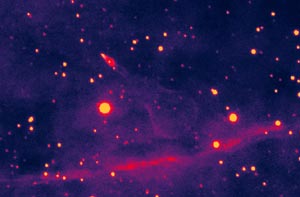Almost every current theoretical model of neutrino masses introduces sterile (“right-handed”) fields, which mix with the ordinary (“left-handed”) neutrinos. Ordinary neutrinos have no electrical charge and interact through the weak force, but there may also exist rogue sterile neutrinos that feel only gravity. Most models make these new particles very heavy, while also trying to explain the small masses of ordinary neutrinos. Now Peter Biermann of the Max Planck Institut for Radioastronomy, Bonn, and Alexander Kusenko of University of California, Los Angeles, have suggested that if some of the sterile neutrinos are relatively light, they could resolve several astrophysical puzzles. In particular, sterile neutrinos with kilo-electron-volt (keV) masses could account for dark matter, the origin of the rapid motion of observed pulsars and re-ionization of the universe (Biermann and Kusenko 2006).

These relatively light sterile neutrinos were the topic of a recent workshop, Sterile Neutrinos in Astrophysics and Cosmology, held in Crans Montana in March. The meeting looked not only at how keV sterile neutrinos can solve a variety of problems in astrophysics, but also at how their existence might be detected.
Dark-matter sterile neutrinos could decay into a lighter neutrino and an X-ray photon, and this seems to be the most promising path to discovery. The workshop brought together particle physicists and X-ray observers, who presented the current limits and discussed ways to search for dark-matter neutrino decays. One important feature of dark matter in the form of the sterile neutrinos is the smoothing of structures on small scales. This “warm” dark matter – in contrast with the “cold” and “hot” alternatives – would be indistinguishable from cold dark matter on large scales, but it would yield stellar structures with the smallest size relative to the dark-matter particle mass. Recent studies of dwarf spheroid satellite galaxies have reported seeing the minimal halo size, indicative of warm dark matter.
The same decays into X-ray photons happening in the early universe could have produced enough ionization to catalyse a rapid production of molecular hydrogen, which is the most important cooling agent for primordial gas. Enriched with molecular hydrogen, haloes of gas would cool and collapse, forming the first stars. These stars could have re-ionized the universe, in agreement with observations of the Wilkinson Microwave Anisotropy Probe.
The role of sterile neutrinos in pulsars originates in supernova explosions, where sterile neutrinos with a mass of several keVs from the cooling nascent neutron star would be emitted preferentially in one direction, set by the star’s magnetic field. Although the neutrinos would not interact with the magnetic field, they would scatter off fermions polarized along the magnetic field in the neutron star. The anisotropy of sterile-neutrino emission would be sufficient to give the neutron star a recoil velocity of hundreds of kilometres a second. This agrees with observations of pulsars – magnetized rotating neutron stars – all of which have very large velocities. The origin of these velocities is a long-standing puzzle, which would have a simple explanation if sterile neutrinos exist.
Further reading
Peter L Biermann and Alexander Kusenko 2006 Phys. Rev. Letts. 96 091301.








